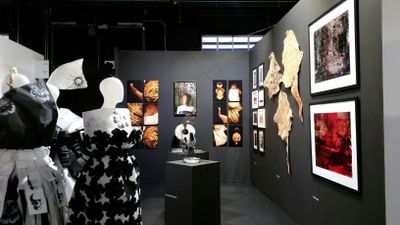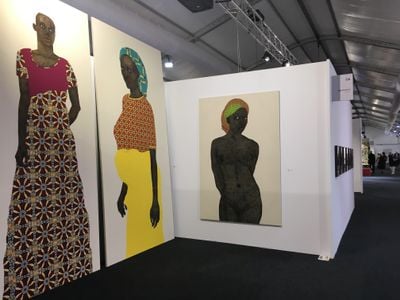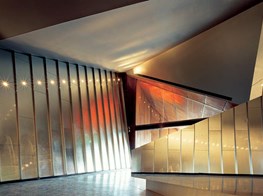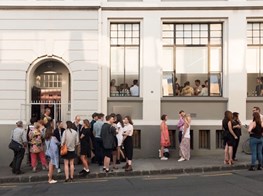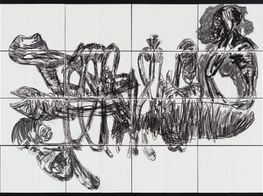Melbourne Art Fair 2018: ‘finding its political and global footing’
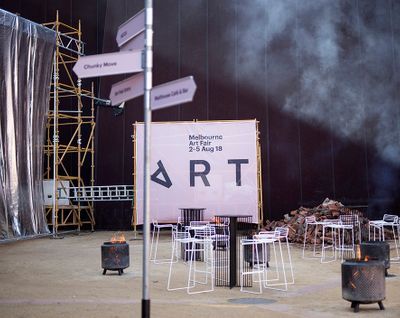
Melbourne Art Fair (2–5 August 2018). Courtesy Melbourne Art Fair.
The fifteenth edition of the biennial Melbourne Art Fair (MAF) (2–5 August 2018), which returned after skipping its 2016 edition, was understated in its ground-level presentation. Forty participating galleries from across Australia, with the exception of eight spaces from New Zealand (including Two Rooms, Michael Lett and Bartley + Company Art) and Manila's The Drawing Room, were divided between Vault Hall, a 2,000 square-metre marquee, and Riding Hall, once the Victoria Police stables now part of the University of Melbourne's Southbank campus. Vault Hall showcased a combination of the Galleries and 'Accent' (for emerging artists with single projects) sectors, while Riding Hall hosted a continuation of Galleries in addition to 'Project Rooms', showcasing cutting-edge non-profit spaces including The Physics Room, the Institute of Modern Art (Brisbane) and Blak Dot Gallery.
Across the city, the fair staged 'TIME', a series of site-specific video works by female practitioners including Michaela Gleave (represented by Anna Pappas Gallery), Angela Tiatia (Sullivan+Strumpf), Sriwhana Spong (Michael Lett Gallery), and Jess Johnson (Darren Knight Gallery) with Simon Ward, as well as talks, tours, events and performances.
A blend of cultural registers was a defining feature of the fair this year, not to mention Melbourne Art Week in general, with exhibitions including the much-hyped 130 Years of Modern and Contemporary Art from the Museum of Modern Art, New York at The National Gallery of Victoria (9 June–7 October 2018), and Blak Design Matters at Koorie Heritage Trust Galleries (21 July–30 September 2018).
At Riding Hall, Ryan Presley's Blood Money Currency Exchange Terminal (2018), presented by Brisbane's Institute of Modern Art, was installed in the building's open-plan foyer as part of Project Rooms. Presley's installation-performance mimics the value and exchange operations of an international currency exchange booth, where visitors are invited to convert Australian dollars (AUD) into 'Blood Money Currency (BMD)' with a cashier who sits slightly elevated behind the glass panel of a bright red desk. These limited-release BMD notes feature warriors of Aboriginal historical resistance, including poet, artist, activist and educator Oodgeroo Noonuccal, and Gurindji activist Vincent Lingiari. The money paid for Presley's notes will directly benefit community organisations such as Carinity Southside Education in Brisbane, and The Gap Youth and Community Centre in Alice Springs—a tongue-in-cheek extraction of reparations for Indigenous communities from those who can afford it, while positioning the performance-installation as a sovereign locus of exchange and praxis.
Expressions of Indigenous power and presence continued in another Project Rooms presentation at Riding Hall. Shades of ochre abounded at Blak Dot Gallery's curated display Native Hands, where Gina Bundle's In Remembrance (2018) showcased delicately painted kangaroo skins inscribed with images of Aboriginal spiritual lore and fauna—cockatoos, stingrays, lyrebirds, and Bunjil, known as the creator and ancestor of the Kulin Nation and often depicted as a wedge-tailed eagle. Lisa Hilli's glowing In a bind (2015), a vivid photograph of a woman whose face is encased by a woven covering, is surrounded by more photographic work that investigates an anti-ethnographic representation of the artist's own body. Underneath the image is Vunatarai Armour (2015), a kaleidoscopic body adornment, which Hilli sees as a feminine response to historical Midi worn only by Tolai men. This cartography of object elements is grounded in the cultural and matrilineal knowledge systems of the Papuan people, and challenges the separation of human bodies in museological displays of historical and cultural artefacts.
On the other side of Blak Dot Gallery, Brisbane-based art dealer Andrew Baker displayed Warrior Woman (2017) by Karla Dickens on the horizontal stretch of the booth: a series of armour-like metal-plated size 12 underwear with items woven into them, including fish hooks, beads, keys, chains, feathers, and bones. Wanting to empower, protect and defend generations of the present and future, Dickens describes Warrior Woman as 'the other side and perspective' of her 'Work Horse' (2015) series, also on view in the space—metal-clad and rusted wall sculptures using forged steel, horse harnesses, and wooden spikes to meditate on the traumatic history of dispossession and domestic abuse.
But despite such welcoming efforts to spotlight First Nations artists, it was Chiharu Shiota, who was introduced during the fair press tour as the 'future of the art fair' in Australia. Shiota's arresting site-specific installation The Crossing (2018)—masses of white fiber threading a pile of dog-eared books with torn out pages that seem to levitate against a black backdrop—was staged at the end of Riding Hall, represented by Melbourne-based Anna Schwartz Gallery. Clearly, this is a visionary artist who makes spectacular artworks with universal appeal, and the books used in Shiota's installation evidently speak to themes around communication and knowledge. But the question of how a work like this relates to the future of an art fair in Australia remains unclear, even if only from the vantage point of being 'global'. Books aren't indicative of the cultures that transmit knowledge through oral practices of storytelling, after all.
With that in mind, encountering The Crossing as the final work on show in Riding Hall felt like approaching a precipice, not because of the lack of artistic merit, but because the connection of the work with the future of the fair feels like a contextually disjointed conclusion to Melbourne Art Fair's commendable curatorial strategy this year, which has given more space to practices that engage with questions of decolonisation that are prefigured in the land on which this fair is situated.
Saying that, Melbourne Art Fair has certainly achieved its goals of supporting contemporary art and living artists, while admirably staying grounded in its locality. Just as the exploration into the rich visual culture of historical and contemporary Indigenous practice is becoming increasingly foregrounded in both institutional and commercial settings throughout Australia, with shows like the landmark 2016 exhibition Sovereignty at the Australian Centre for Contemporary Art (17 December 2016–26 March 2017), Defying Empire at the National Gallery of Australia in Canberra (26 May–10 September 2017), and Karrabing Film Collective's ongoing, first solo exhibition at the Institute of Modern Art in Brisbane (30 June–30 August 2018). If anything, the fair is a clear reflection of the current state of the Melbourne art scene and the wider scene in general, which are both still finding their political and global footing.
One work that embodies this position is Ronnie van Hout's larger-than-life Surrender (2018), presented inside the entrance to Vault Hall: this year's biannual Commission by the Melbourne Art Foundation in partnership with Bendigo Art Gallery and supported by Artwork Transport. As one of Australia's oldest and largest regional art galleries, the spotlight on van Hout's commission, which will later enter Bendigo Art Gallery's collection, speaks to the growth and reach of Australian art acquisition. Two cast polyurethane and fibreglass soldiers standing at over two metres are frozen in a position of surrender, hands up and head bowed; they come from van Hout's long-standing career of moulding his own facial features and expressions onto his works. While the artist sees these figures as a representation of 'a moment where we abstain from self,' they also draw connections between ongoing global dialogues around how war is memorialised and exalted, not to mention how it continues today.1
Intersecting global perspectives in the Vault Hall continued at Adelaide's GAGPROJECTS. Pierre Mukeba's towering oil paintings offer just enough figurative detail to not appear as abstractions, presenting intimate portraits where painted and seemingly half-painted figures are framed with textile accents that cover their bodies as clothing and blankets. Survival Decision (2018) depicts a woman sprawled, eyes resolute as she holds a seemingly translucent figure close to her, with bold colours and patterns encasing them. The fabrics applied to Mukeba's canvases are sourced from the artist's birthplace in Congo. Their use in these compositions allows for personal moments, such as the artist's experience of resettlement in Australia, to be read alongside the wider cultural significance of the fabrics themselves. Moving between intimate specificity and broader contextual histories, these paintings function as points of refractive connection for the artist's African-Australian experience.
The idea of art as a point of mediation that takes into account the broad universe of visual cultures and artistic languages that connect to historical struggles for self-determination, is a notion that Melbourne Art Week in general appears to be taking into account. The Melbourne Art Fair hosted its press conference at the Australian Centre for Contemporary Art (ACCA), where one of the event's key satellite exhibitions is being staged. Curated by Hannah Presley, A Lightness of Spirit is the Measure of Happiness (7 July–16 September 2018) is a profound and witty reflection on contemporary Aboriginal life through the works of 13 artists from southeast Australia and beyond, including Benita Clements, Vicki Couzens, Robert Fielding, Jonathan Jones, Peter Mungkuri, Vincent Namatjira, Jimmy Pompey, Peter Waples-Crowe, Lisa Waup, Kaylene Whiskey, and Tiger Yaltangki.
The title of the exhibition comes from filmmaker and legal academic Larissa Behrendt's essay 'The Things You Shouldn't Say to an Aboriginal Person' (2015), which considers happiness as a broader concept for thinking of ways to live, in spite of trans-generational trauma and an ongoing struggle for sovereignty. Works on view include Kokatha and Nukunu artist Yhonnie Scarce's 'Remember Royalty' (2018): a commemoration of the artist's ancestors. Bush tucker—or bushfood—is recreated in the form of yams, bush bananas, and plums in blue glass, which are placed in a suitcase, chest, and toolbox positioned underneath photographs printed on linen and cotton cloths that hang from the ceiling, showing images drawn from family archives.
In the next room, Indulkana artists Alec Baker, Peter Mungkuri and Mr Kunmanara Pompey's spaghetti western film, Never Stop Riding (2017) brings together comedic gunshots, gleaming eyes, feats of heroics and uninhibited dancing in a series of acts that re-appropriates the myth of the cowboy as masculine freedom fighter to the Aboriginal Australian context. The film, like the rest of the exhibition, brims with resilience and subversive joy. You might call it the projection of a future. —[O]
—
1See here.
~ ~

